Your cart is empty now.
This is a book written for ordinary people by an ordinary person. There is no scholarship hare, no erudition. There are no reference to, or quotations from, hundreds of books. There is no expertise in Orientology, nor anything that may be considered as a deep riddle or mystery. This book does, however, distinct viewpoint. This is not a history of Indian culture. It does not contain information about the advances we have made in the field of the arts and sciences, or in trade, commerce or politics. There are no new historical accounts of Chandragupta or Ashoka, Kalidasa or Tansen, Aryabhatta or Bhaskaracharaya. It is the soul of Indian culture that we meet here. We have here an entrance into the inner sanctuary of Indian culture.
We often hear the phrase "Indian culture." We hear or read in lectures or essays sentences like these: "This is unworthy of Indian culture" or "This is harmful to Indian culture". What do we mean by Indian culture on such occasions? When such sentences are spoken or written we certainly do not have in mind the history of Indian culture. What we have in mind is a vision, a viewpoint, that is unique to Indian culture. What is that vision? What is that point of view? That is what I have tried to show in this book.
The thought embodied in this book have been expressed by me in many lectures and discourses. It was often suggested to me by several methods of my audiences that I should write down these thoughts. I have written short essays for their satisfaction. It was scarcely possible for me to show in these brief essays the countless shades of Indian culture. I am offering here only a few glimpses.
I have heard many of these thoughts from the lips of great men. What I have heard has helped me to develop the feelings latent in my own heart. Some of the valuable ideas of respected Vinobaji of the Wardha Satyagrahashram have found a place in this book. In my chapters on Karma, Knowledge, Devotion, Non-violence and Renunciation of the Fruit from Vinobaji. He of course, in no way responsible for what I have written. He planted these seeds in my mind and heart. The errors are mine, the truth is his.
Indian culture adores the heart as well as intellect. It is a culture which makes life beautiful through a combination of purity of knowledge and generosity of feeling. It is culture which seeks to unite the mind's knowledge with the heart's feeling and thereby spread sweetness over the world. "Indian Culture" means the living glory of action, knowledge and devotion the glory of employing continuously the body, the mind and the heart in true service.
Indian culture means sympathy and compassion. Indian culture means vastness and exaltation. Indian culture means experimentation with truth. Indian culture means the refusal to remain static and to move forward in a constant search for knowledge. This is a culture which grows by accepting whatever is true, good and beautiful in the universe. It worships all the sages and seers of the world. It respects the founders of all religions. Wherever it sees greatness, Indian culture worships it and preserves it respectfully and joyously.
It is a culture which rejects narrow-mindedness. And that is why when I hear the words "Indian culture" my hands are spontaneously folded in adoration. When I utter the words "Indian culture", image of two vast phenomena come before my eyes: the ocean and the sky. Two sacred things illumine my eyes: light and the lotus flower. I think of restraint, sacrifice, renunciation, service, love, knowledge and discrimination. Indian culture means going from the finite to the infinite, from darkness to light, from difference to identity, from the mud to the lotus flower, from conflict to growth, from distortion to true judgment, from confusion to order, from shouting to music. Indian culture means union: the union of all religions, of all races, of all sciences, of all ages. My only longing is: 'May I be born again and again as a humble worshiper-at least mentally of this great culture which seeks to bring about such a grand union, which strive to lead mankind on the road leading to blessedness.'
When Professor G.N. Joshi, Director of the Marathi Encyclopaedia of philosophy, suggested that I should prepare an English translation of Sane Guruji's book on Indian culture, I hesitated for a long time before accepting the assignment. The book has been written with so much sensitivity, and with such intimate familiarity with the daily life of the simple, ordinary people of rural Maharashtra, that I felt extremely diffident. I thought that it would be next to impossible to convey in an English idiom a book in which the author has left the stamp of his personality on every page and has expressed his ideas and emotions in colloquial language intelligible to ordinary folk.
On further reflection, however, I realized that these very qualities of the book, which causes my hesitation, made it imperative that it should be made available to a wider circle of readers than that for whom the author wrote it. This book is unique because it is free from intellectual pretensions and literary ornamentation, although Sane Guruji was an immensely well-read man with the heart, not merely with the mind. Though intended for the Marathi reader, it reflects the joys and sorrows, hopes and aspirations, successes and disappointments of all Indians, irrespective of differences of caste, creed and culture. It is animated by the breath of India.
Sane Guruji was one of the finest products of Indian nationalism. The patriotism that is revealed in his book is pure, genuine and intense without any trace of jingoism. The author's love for his motherland was an inseparable part of his love of humanity. He did not glorify his country uncritically. In his presentation of Indian culture he draws attention to the abiding qualities of our tradition without hiding the cruelty, superstition, blind faith and other negative features that have hindered the nation's progress.
Today, when religious fanaticism and regional divisiveness are threatening the very foundations of our national culture, Sane Guruji's book is all the more valuable and significant. We find here a total absence of prejudice or intolerance in any form. Recognition has been given here to all the major faiths that have met on Indian soil and have contributed to the evolution of a composite tradition. The author's love of nature is also evident in every chapter; and in our age, when protection of the environment has become a prime concern, Sane Guruji's deep sensitiveness to India's mountains, rivers and lakes, flora and fauna, can be a source of inspiration to those working for the conservation of our environment.
While reading the Marathi text, I was deeply moved by the author's anguish at the misery of the millions of our countrymen who have been exploited and oppressed. Sane Guruji's admiration and reverence for Mahatma Gandhi, and his deep affection for Pandit Jawaharlal, also made a profound impression on me. Sane Guruji's socialism was a natural extension of his nationalism. In this book we have made an attempt to preserve the positive aspects of India's ancient attitudes and assumptions and also to reinterpret them in the light of social and historical changes. We have here a synthesis of a traditional and the modern, of the perennial and the contemporary, of nationalism and cosmopolitanism. The author exhorts his readers to study, observe, acquire knowledge about what is right and what is wrong with India, to judge everything in the light of reason without rejecting the guidance of insight, intuition, vision and faith. Written with humility and tenderness, the book shows occasional glimpses of delicate poetic awareness.
This does not mean that the contemporary reader will agree with everything that Sane Guruji has said. Sometimes his love of traditional values has led him to rationalize beliefs, practices and even rituals that have outlived their relevance. On the question of the role of woman in Indian society, his unequivocal praise of the "Sita-Savitri" ideal may not appeal to many of us. It should be remembered that the book was written more than half a century ago. There is no reason to believe that if Sane Guruji had been alive today he would have obstinately stuck to his views and refused to modify his assertions in the light of criticism. Even on those few occasions when we may find his views unacceptable, his disarming sincerity and simplicity cannot be doubted.
Let me conclude by saying that, though the work of translating this book has not been essay, I have enjoyed the experience and found it immensely educative and uplifting. I have a sense of worth whileness in being able to offer to English readers a classic produced by someone who was not only a fine and unusually versatile writer but also a noble and lovable person.
Sane Guruji was a saint-patriot, an erudite scholar and an eminent Marathi writer. He was a keen student of philosophy and religion. In 1937 Sane Guruji wrote 'Bharatiya Samskriti', a profound treatise elucidating his ideas of Indian Culture. In this book Sane Guruji interprets the value and customs, rites and rituals, systems and institutions of Indian Culture in the light of the lives and teachings of the seers and saints. The chapter on 'Symbols' refreshingly original. Sane Guruji looks at Indian Culture from the advaitin's point of view advaita Monism interpreted not only in terms of spiritual unity but in terms of physical and social unity. He looks upon Dharma as the foundation of Indian culture. He re-tells episodes from the scripture, epics and Puranas to illustrate some of the great ideals of Indian Culture. He does not confine himself only to Indian writers, both ancient and modern, but also quotes library from western thinkers, Sane Guruji wrote this treatise in 1937. He had his contemporary political life before his mental eye. The geopolitical situation kept changing ever since. Today's readers may not agree with some of Sane Guruji's evolution of personalities and events. Some of his observations may be deemed obsolete in the present context. However we expect the reader to appreciate this situation. The thrust of his argument is more significant then the details of his observations. We have, after great consideration, retained his original argument in the present translated version.
We are most grateful to Dr. Vishwanath S. Naravane, an eminent Professor of Philosophy and author of several books, for his commendable translation of Bharatiya Samskriti. Dr. Naravane undertook this task at the instance of Dr. G.N. Joshi, himself a keen student of philosophy and Director of the Council for the Marathi Encyclopaedia of Philosophy. Dr. G.N. Joshi regards Sane Guruji as his Guru and we thank him for his association with Sadhana of Pune, the publishers of 'Bharatiya Samskriti' in Marathi, for giving permission to publish the English rendering. We are deeply indebted to Shri Ramesh Sarkar, the editor of Aryan Path, and a scholar of modern English, for helping us prepare the final version of the text. The proof-correction being a complicated job, had to be handled skillfully and Smt. Kumud Karkare willingly accepted it. A special mention must be made of Smt. Sangeeta Bapat who, under the guidance of Prof. Vasant Bapat, read the final proofs.
The original text contained quite a few Sanskrit and Marathi quotations. In the English translation, the reader would find only the import of the original quotations in the text; the quotations are given as footnotes. While going through the proofs, we found ourselves in a dilemma. It was difficult to decide whether Indian words i.e. Sanskrit, Hindi or Marathi words should be transliterated with diacritical marks and thus facilitate accurate pronunciation, or transliterate arbitrarily. It is true that diacritical marks alone mark the value of vowels; but these are impediments to fluent reading. We also found that in different regions of India, the same word is spelt differently. Rama with diacritical mark on the first 'a' would give us proper pronunciation but without the diacritical mark the world would either stand for Rama or Rama. Ultimately we were obliged to accept the usual way of spelling such words. True, the choice was made arbitrarily but readers would decide upon the accuracy of the pronunciation in the light of the context. We also realize that but for the assistance of a number of knowledgeable persons and artists, the work would not have been accomplished. Thanks are also due to the painstaking printing-technicians and helpful material-suppliers. Last, but not the least, we most gratefully acknowledge the munificent gesture of Shri Digambar Parulekar of Belgaum, who gave us the stimulus to undertake this arduous task.
The book is perhaps not voluminous but its final publication took an inordinately long time. We hope the readers would appreciate all these hurdles and pardon us for the delay. We vary humbly assure them that every care has been taken to remove blemishes. The outcome is the joint effort of Bharatiya Vidya Bhavan and Sadhana Prakashan. This book for us is our homango to Sane Guruji in the year of his Birth Centenary.
We trust that the English translation would communicate Sane Guruji's ideology to the non-Marathi reader. We feel that 'Bharatiya Samskriti' may prove to be one of our epic publications and would be a companion to Bharatiya Vidya Bhavan's publication, 'Hindu Dharma: The Universal Way of Life' by Kanchi Paramacharya, Pujyasri Chandrasekharendra Saraswati Swami.
| * | Sane Guruji Foreword to Bharatiya Samskriti | vii |
| * | Translator's Preface | ix |
| * | Sane Guruji : A Brief Sketch | xi |
| * | Publisher's Note | xiii |
| 1. | Oneness: The Foundation | 01 |
| 2. | Face to Face with the one | 08 |
| 3. | The Glory of the Intellect | 16 |
| 4. | Sages as Experimenters | 25 |
| 5. | Caste, Aptitude, Vocation | 34 |
| 6. | Action | 39 |
| 7. | Devotion | 49 |
| 8. | Knowledge | 61 |
| 9. | Restraint | 67 |
| 10. | Renunciation of the Fruits of Action | 75 |
| 11. | Teacher and Disciple | 84 |
| 12. | The Four Ends of Life | 91 |
| 13. | The four Stages of Life | 115 |
| 14. | The Nature of Womanhood | 131 |
| 15. | Loving Relationship with Non-Human Nature | 141 |
| 16. | Non-Violence | 150 |
| 17. | The Cultivation of Strength | 168 |
| 18. | Ideals Held Supreme | 180 |
| 19. | The Concept of Avatara | 189 |
| 20. | Image-Worship | 195 |
| 21. | Symbols | 204 |
| 22. | Shri-Krishna and his Flute | 218 |
| 23. | The Poetry of Death | 226 |
| * | Epilogue | 234 |
| * | Appendices | 235 |
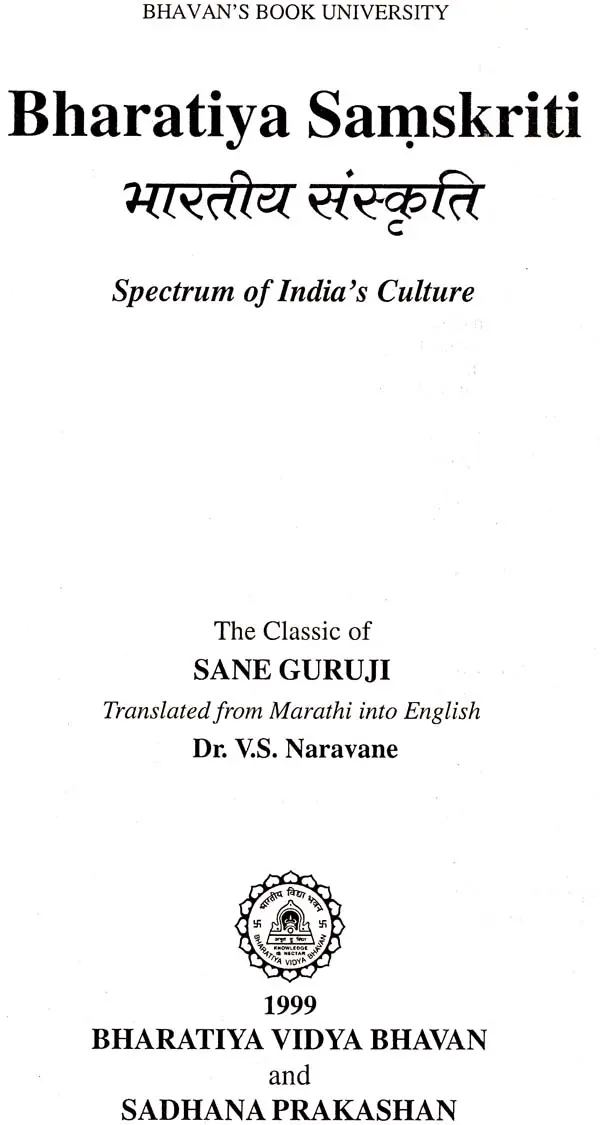
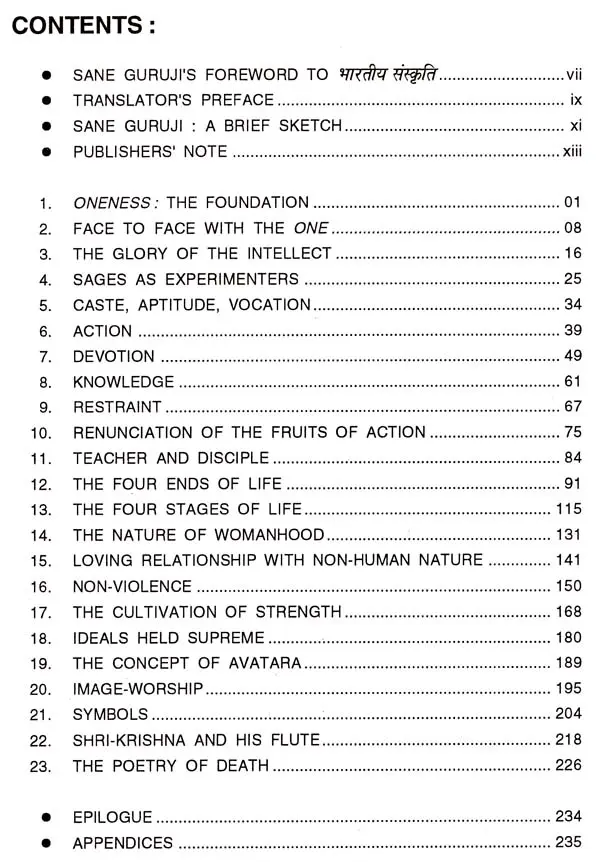



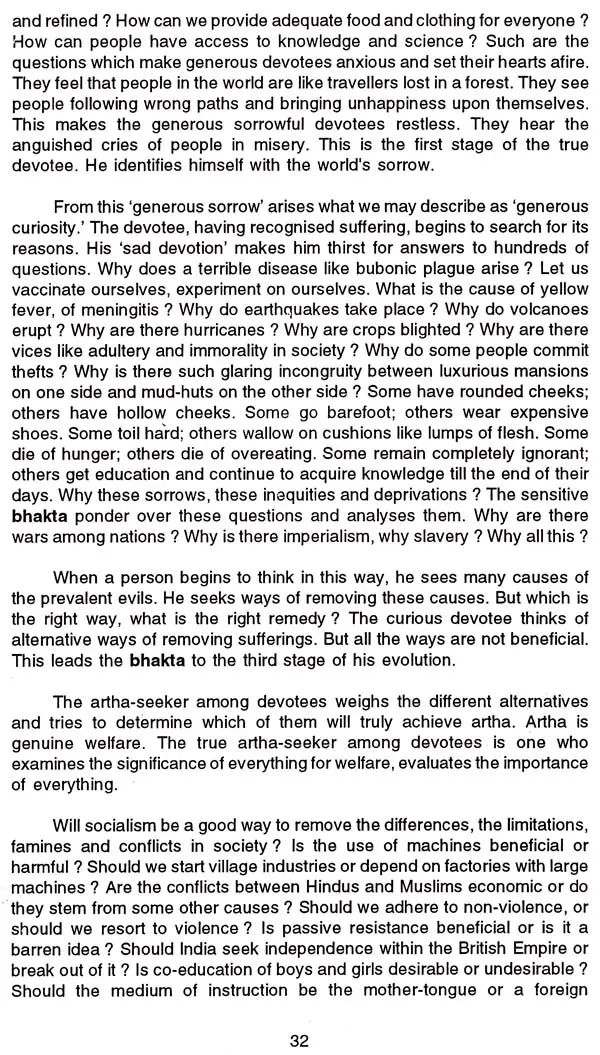

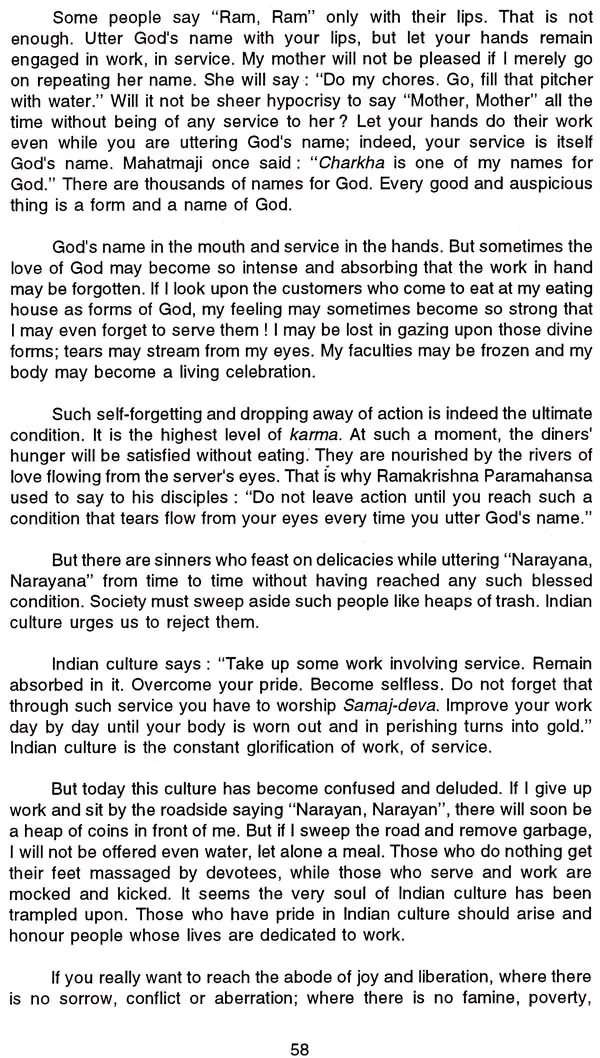
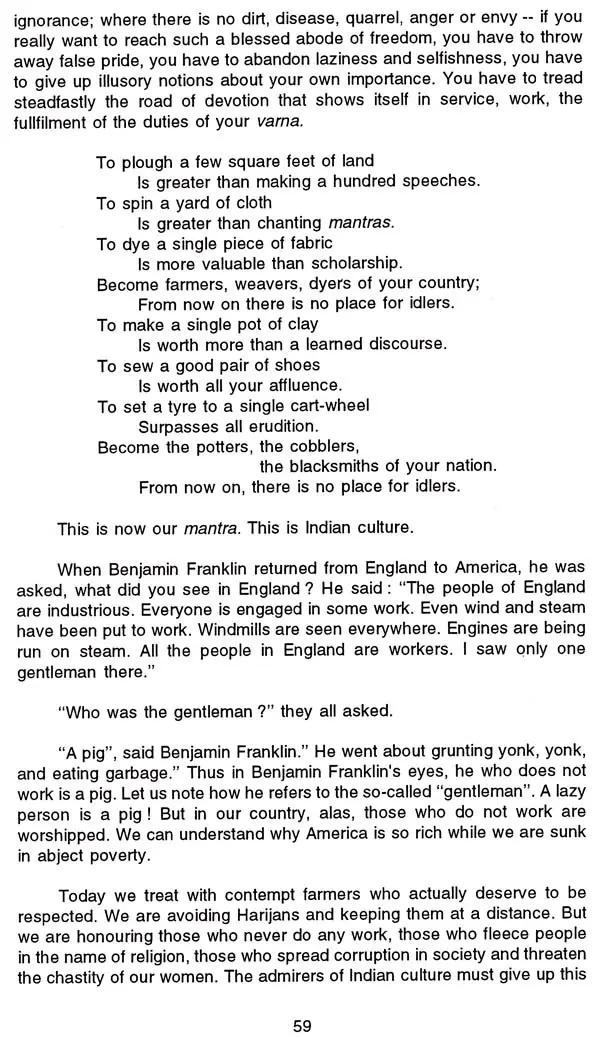

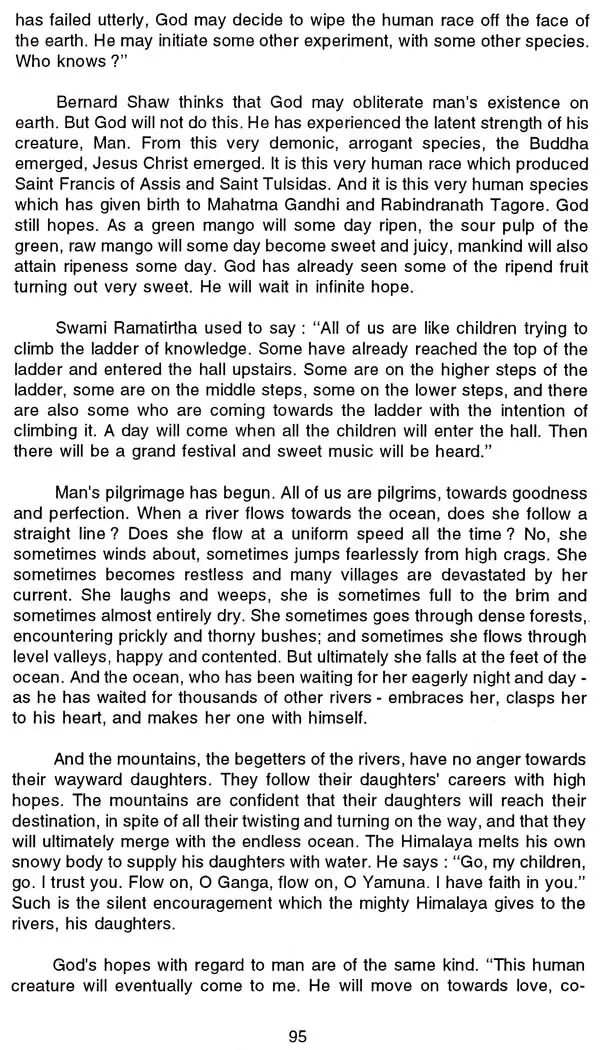
Delivery and Shipping Policy
- INTERNATIONAL SHIPPING
- Rs.1000-1100/kg
- ESTD. Delivery Time: 2-3 weeks (depending on location)
- Bubble Wrapped with Extra Padding
- NATIONAL SHIPPING
- NCR: Rs. 30/half kg
- Standard: Rs. 80/half kg
- Express shipments also available on Request
- ESTD. Delivery Time: Ranging from 1-4 days up to 7 business days (Depending on your choice of Delivery)
- TRACKING
- All orders; national or international, will be provided with a Tracking ID to check the status of their respective orders
- Depending on the Shipping Service, Tracking ID may be used on their respective tracking portals
Frequently Asked Questions (FAQs)
Domestic Shipping: 3-4 Days (after shipping)
International Shipping: 1-2 weeks (based on your location)
You will receive an email once your order has been shipped or you can email us if you didn't receive tracking details (info@mlbd.co.in)
Every book that we sell is the latest edition except all the rare books
Yes, we do provide free shipping, only on domestic orders (within India) above Rs.1500











